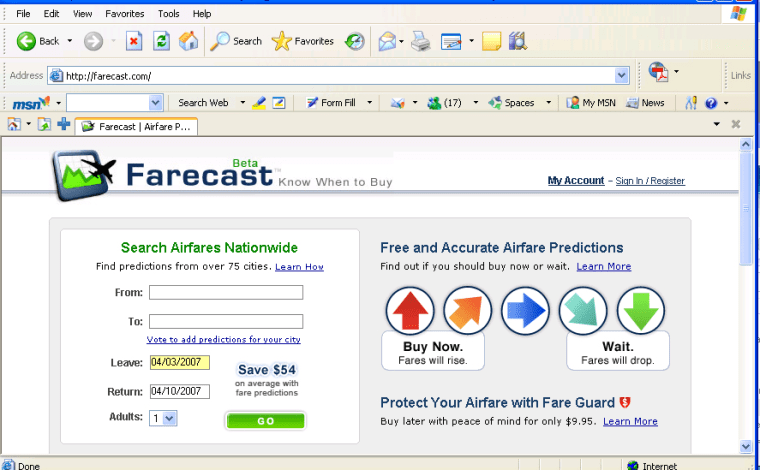To buy or not to buy — that could be the question.
Or, if the purchase at hand is a plane ticket, perhaps the question should be, To buy now or buy later. There may not be a definitive, one-price-fits-all answer to that particular riddle, but some very smart people have come up with some very intriguing ideas on the subject.
It’s all part of the brave new world of online travel, that ever-expanding universe where new technologies and innovative ideas are influencing everything from where people go to how they get there. A click here, a few keystrokes there, and you can find Web-only deals, pick other travelers’ brains, even find potential seatmates or travel partners.
Or, you can get completely overwhelmed by the ever-accelerating assault of information. Who really offers the best deals? Whose advice can you really trust? And with new travel-related Web sites popping up like spring crocuses, who are you going to give your online dollars to?
I can’t answer that, but I’ve been talking to a lot of entrepreneurs and industry analysts lately, and they all agree that ongoing technological developments are empowering consumers like never before. With spring break here and summer vacation right around the corner, it seems like a good time to embark on an extended (i.e., multi-column) tour of some of the options.
Airfare roulette
Purchasing a plane ticket at a good price has been likened to everything from playing the stock market (exceedingly volatile) to Russian roulette (the ultimate crap shoot). Personally, I’ve always thought of it as more akin to a Magic 8-Ball. (Is this a good fare? Answer hazy, try again.)
“There’s no such thing as a set airfare price,” says Henry Harteveldt, vice president and travel analyst at Forrester Research. “There hasn’t been one in 28 years — and it’s unlikely we’ll ever see one again.”
And yet, according to those in the know, there’s a method to the madness. Sifting through years of pricing data and billions of transactions, several companies are using the historical patterns they’ve found to provide more context for current fares and even predict future ones.
At , those patterns take the form of itinerary-specific graphs of last year’s minimum fares and listings of current minimum fares for travel booked over the next 12 months. The latter are given star ratings that indicate how close the current price is to the historical low. “If you have four stars, you can buy with confidence,” says Neil Bainton, Farecompare COO. “If you have one star, you might want to wait.”
Other travel Web sites are also helping users put current prices in historical context. Click on the Best Fare Trend box at , and you’ll not only get a graph of the lowest fares over the last 90 days, but also a list of recent prices found by other users searching the same itinerary over the last 48 hours. Essentially, you can haul in a good deal after someone else has done the heavy lifting.
Meanwhile, has just launched TripStarter, which provides background data for thousands of city-pair flights. Plug in your departure and destination cities, and the tool will display a graph with up to two years of average prices for both airfares and hotels. Noting the seasonal highs and lows and seeing how current prices track with historical ones can be a big help when you’re budgeting your next trip.
Foreseeing future fare
Historical data is good; the folks at believe they have something better. Backed by a database of 175 billion (and growing) airfares, the company predicts whether airfares will rise, fall or hold steady over the next seven days and whether consumers should buy now or wait for a better price. The company also recently launched Farecast Deals, a new service designed to separate true bargains (based on even more number crunching) from those based on marketing hype.
The company makes 40 million predictions per month and claims an accuracy rate of 70–75 percent. (My personal research pegged it at 60–65 percent; then again, I slept through my college statistics class.) “We’re not clairvoyant,” says Farecast president and CEO Hugh Crean. “We’re looking to provide unbiased, transparent information that empowers consumers.”
Ultimately, that’s what all these next-gen travel Web sites are about, i.e., turning massive quantities of raw data into products that consumers can use to make more informed decisions. They’re not perfect — some don’t include all fees and taxes, others list fares for seats that aren’t available — but they can certainly help take some of the anxiety out of hitting that “Buy now” button.
“They’re not 100 percent perfect 100 percent of the time, but they get points for being creative,” notes Harteveldt. “Travelers are getting smarter, and these sites are helping them get there.”
